Citroen JUMPER 2014 2.G Owner's Manual
Manufacturer: CITROEN, Model Year: 2014, Model line: JUMPER, Model: Citroen JUMPER 2014 2.GPages: 240, PDF Size: 7.71 MB
Page 131 of 240
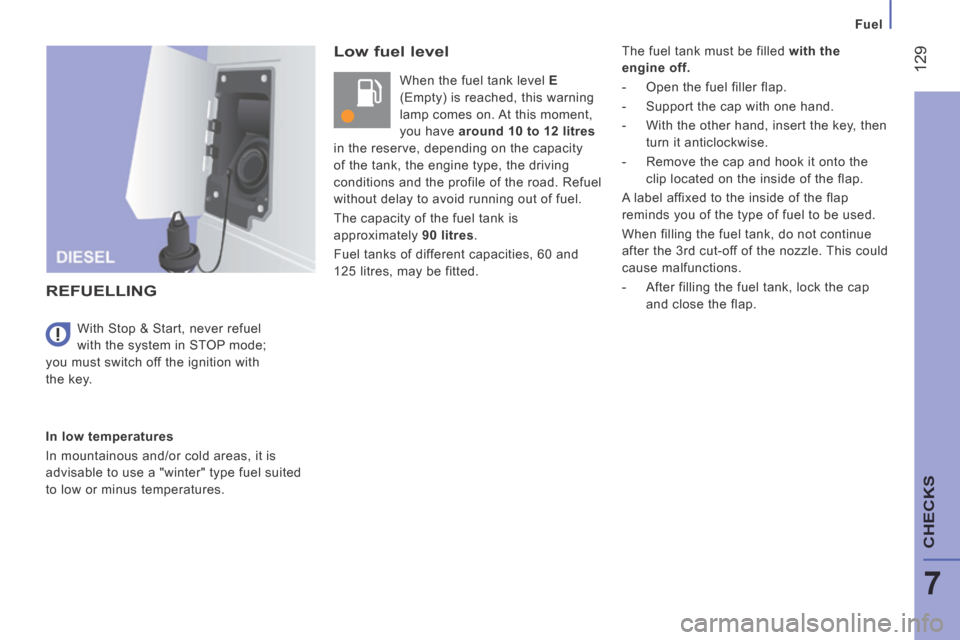
Fuel
129
7
CHECKS
JUMPER-PAPIER_EN_CHAP07_VERIFICATIONS_ED01-2014
Low fuel level
When the fuel tank level E
(Empty) is reached, this warning
lamp comes on. At this moment,
you have around 10 to 12 litres
in the reserve, depending on the capacity
of the tank, the engine type, the driving
conditions and the profile of the road. Refuel
without delay to avoid running out of fuel.
The capacity of the fuel tank is
approximately 90 litres.
Fuel tanks of different capacities, 60 and
125 litres, may be fitted.
REFUELLING
In low temperatures
In mountainous and/or cold areas, it is
advisable to use a "winter" type fuel suited
to low or minus temperatures. With Stop & Start, never refuel
with the system in STOP mode;
you must switch off the ignition with
the key. The fuel tank must be filled
with the
engine off.
- Open the fuel filler flap.
- Support the cap with one hand.
- With the other hand, insert the key, then turn it anticlockwise.
- Remove the cap and hook it onto the clip located on the inside of the flap.
A label affixed to the inside of the flap
reminds you of the type of fuel to be used.
When filling the fuel tank, do not continue
after the 3rd cut-off of the nozzle. This could
cause malfunctions.
- After filling the fuel tank, lock the cap and close the flap.
Page 132 of 240
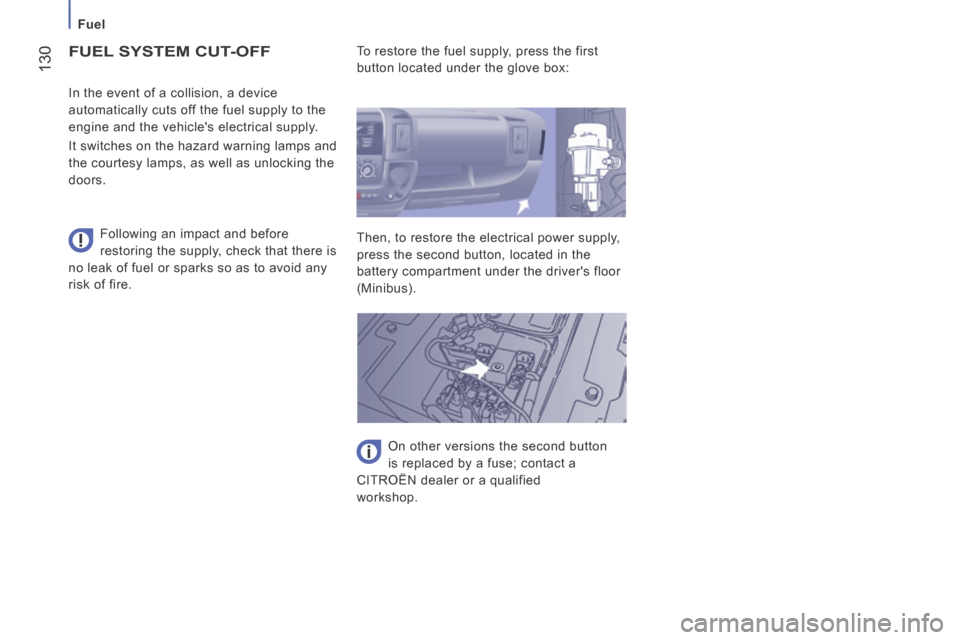
Fuel
130
JUMPER-PAPIER_EN_CHAP07_VERIFICATIONS_ED01-2014
FUEL SYSTEM CUT-OFF
Following an impact and before
restoring the supply, check that there is
no leak of fuel or sparks so as to avoid any
risk of fire. In the event of a collision, a device
automatically cuts off the fuel supply to the
engine and the vehicle's electrical supply.
It switches on the hazard warning lamps and
the courtesy lamps, as well as unlocking the
doors. To restore the fuel supply, press the first
button located under the glove box:
Then, to restore the electrical power supply,
press the second button, located in the
battery compartment under the driver's floor
(Minibus).
On other versions the second button
is replaced by a fuse; contact a
CITROËN dealer or a qualified
workshop.
Page 133 of 240
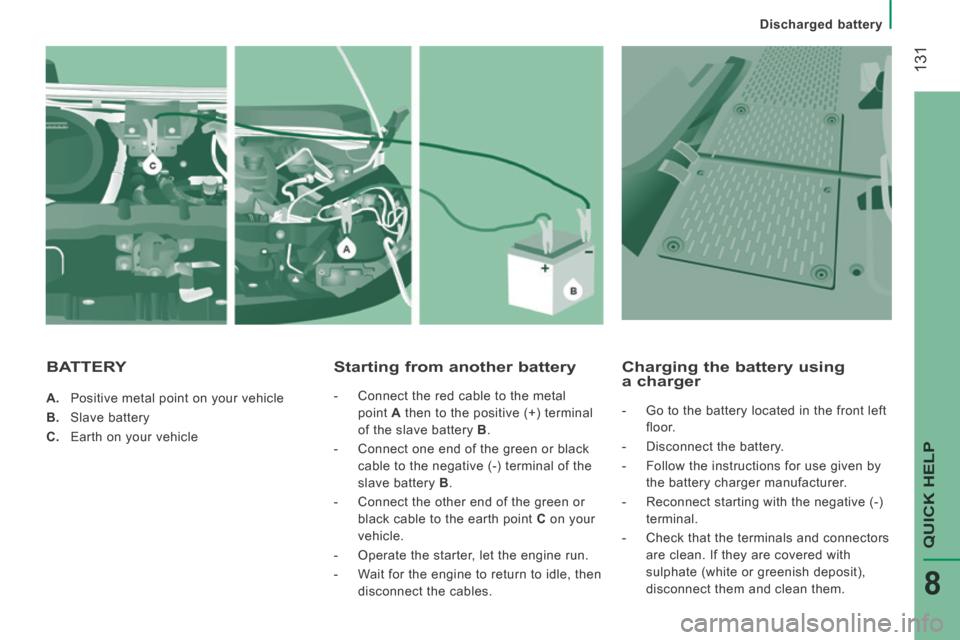
131
Discharged battery
QUICK HELP
8
JUMPER-PAPIER_EN_CHAP08_AIDE RAPIDE_ED01-2014
A. Positive metal point on your vehicle
B. Slave battery
C. Earth on your vehicle
Starting from another battery
- Connect the red cable to the metal point A then to the positive (+) terminal
of the slave battery B .
- Connect one end of the green or black cable to the negative (-) terminal of the
slave battery B .
- Connect the other end of the green or black cable to the earth point C on your
vehicle.
- Operate the starter, let the engine run.
- Wait for the engine to return to idle, then disconnect the cables.
Charging the battery using a charger
- Go to the battery located in the front left floor.
- Disconnect the battery.
- Follow the instructions for use given by the battery charger manufacturer.
- Reconnect starting with the negative (-) terminal.
- Check that the terminals and connectors are clean. If they are covered with
sulphate (white or greenish deposit),
disconnect them and clean them.
BATTERY
Page 134 of 240
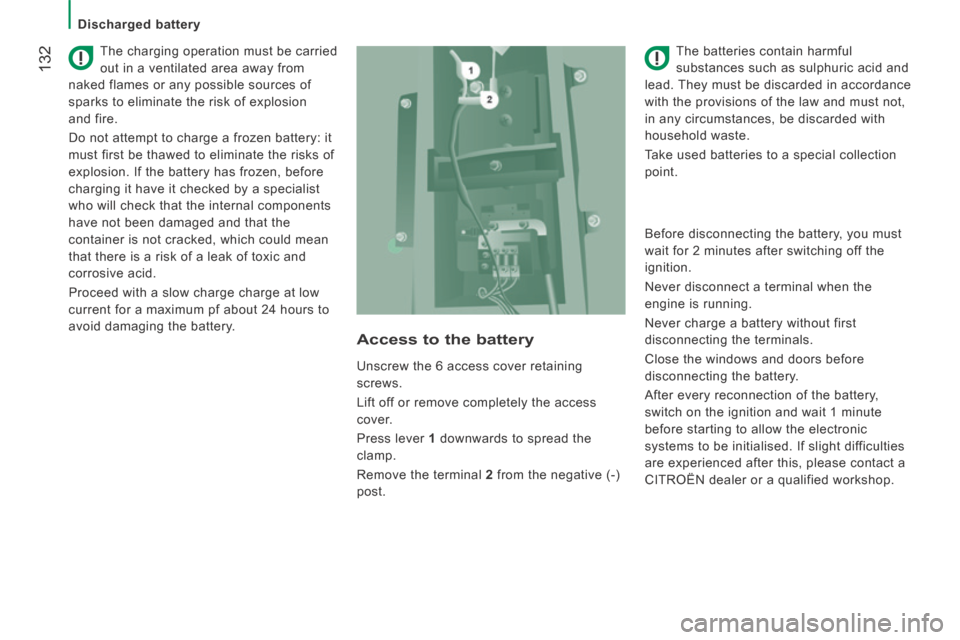
132
Discharged battery
JUMPER-PAPIER_EN_CHAP08_AIDE RAPIDE_ED01-2014
The charging operation must be carried
out in a ventilated area away from
naked flames or any possible sources of
sparks to eliminate the risk of explosion
and fire.
Do not attempt to charge a frozen battery: it
must first be thawed to eliminate the risks of
explosion. If the battery has frozen, before
charging it have it checked by a specialist
who will check that the internal components
have not been damaged and that the
container is not cracked, which could mean
that there is a risk of a leak of toxic and
corrosive acid.
Proceed with a slow charge charge at low
current for a maximum pf about 24 hours to
avoid damaging the battery. The batteries contain harmful
substances such as sulphuric acid and
lead. They must be discarded in accordance
with the provisions of the law and must not,
in any circumstances, be discarded with
household waste.
Take used batteries to a special collection
point.
Before disconnecting the battery, you must
wait for 2 minutes after switching off the
ignition.
Never disconnect a terminal when the
engine is running.
Never charge a battery without first
disconnecting the terminals.
Close the windows and doors before
disconnecting the battery.
After every reconnection of the battery,
switch on the ignition and wait 1 minute
before starting to allow the electronic
systems to be initialised. If slight difficulties
are experienced after this, please contact a
CITROËN dealer or a qualified workshop.
Unscrew the 6 access cover retaining
screws.
Lift off or remove completely the access
cover.
Press lever
1 downwards to spread the
clamp.
Remove the terminal 2 from the negative (-)
post.
Access to the battery
Page 135 of 240
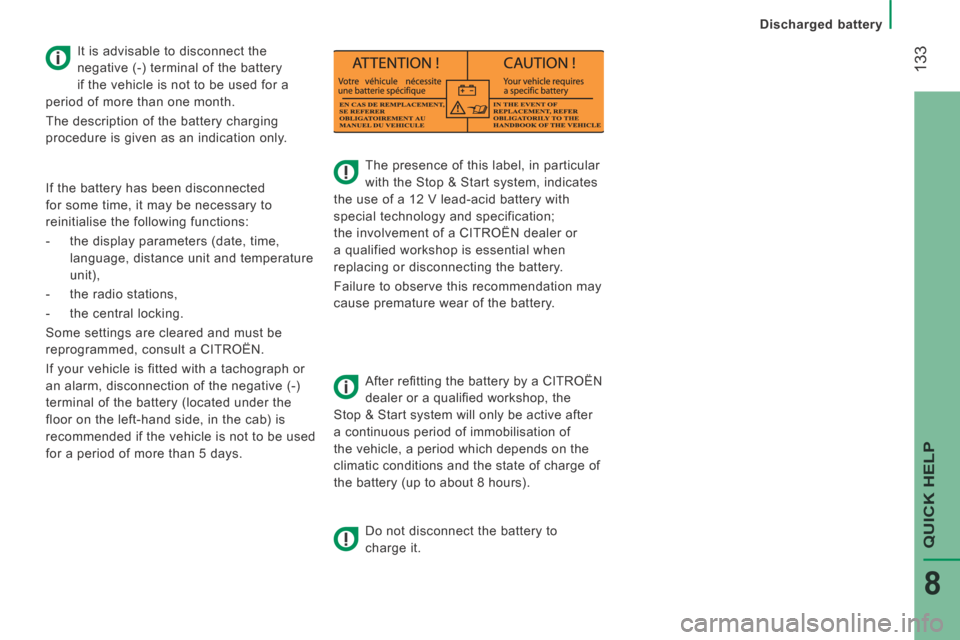
133
Discharged battery
QUICK HELP
8
JUMPER-PAPIER_EN_CHAP08_AIDE RAPIDE_ED01-2014
The presence of this label, in particular
with the Stop & Start system, indicates
the use of a 12 V lead-acid battery with
special technology and specification;
the involvement of a CITROËN dealer or
a qualified workshop is essential when
replacing or disconnecting the battery.
Failure to observe this recommendation may
cause premature wear of the battery.
After refi tting the battery by a CITROËN
dealer or a qualifi ed workshop, the
Stop & Start system will only be active after
a continuous period of immobilisation of
the vehicle, a period which depends on the
climatic conditions and the state of charge of
the battery (up to about 8 hours).
Do not disconnect the battery to
charge it.
It is advisable to disconnect the
negative (-) terminal of the battery
if the vehicle is not to be used for a
period of more than one month.
The description of the battery charging
procedure is given as an indication only.
If the battery has been disconnected
for some time, it may be necessary to
reinitialise the following functions:
- the display parameters (date, time, language, distance unit and temperature
unit),
- the radio stations,
- the central locking.
Some settings are cleared and must be
reprogrammed, consult a CITROËN.
If your vehicle is fitted with a tachograph or
an alarm, disconnection of the negative (-)
terminal of the battery (located under the
floor on the left-hand side, in the cab) is
recommended if the vehicle is not to be used
for a period of more than 5 days.
Page 136 of 240
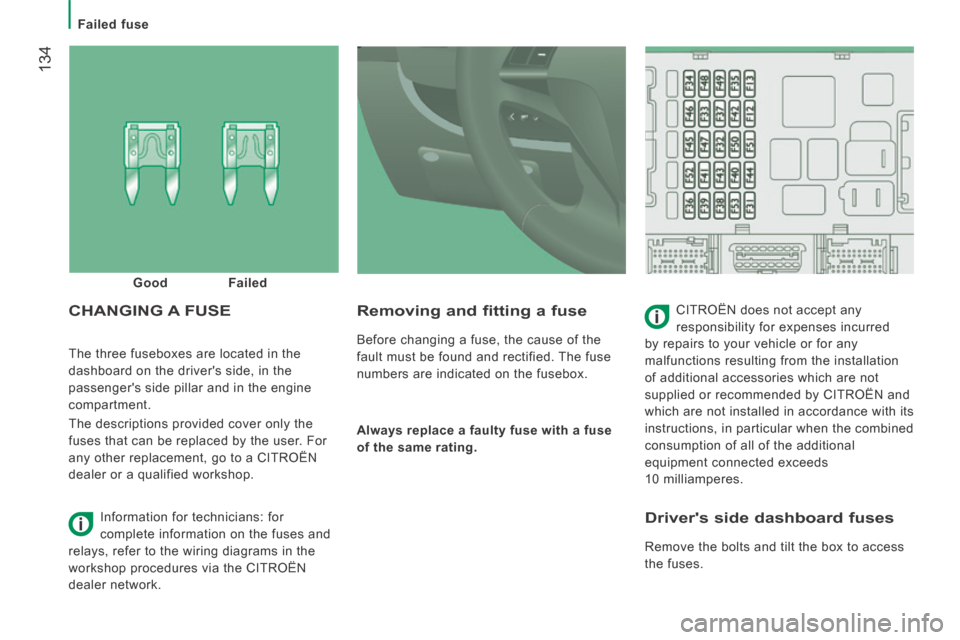
Failed fuse
134
JUMPER-PAPIER_EN_CHAP08_AIDE RAPIDE_ED01-2014
The three fuseboxes are located in the
dashboard on the driver's side, in the
passenger's side pillar and in the engine
compartment.
The descriptions provided cover only the
fuses that can be replaced by the user. For
any other replacement, go to a CITROËN
dealer or a qualified workshop.
Removing and fitting a fuse
Before changing a fuse, the cause of the
fault must be found and rectified. The fuse
numbers are indicated on the fusebox.
Always replace a faulty fuse with a fuse
of the same rating.
CHANGING A FUSE CITROËN does not accept any
responsibility for expenses incurred
by repairs to your vehicle or for any
malfunctions resulting from the installation
of additional accessories which are not
supplied or recommended by CITROËN and
which are not installed in accordance with its
instructions, in particular when the combined
consumption of all of the additional
equipment connected exceeds
10 milliamperes.
Good
Failed
Information for technicians: for
complete information on the fuses and
relays, refer to the wiring diagrams in the
workshop procedures via the CITROËN
dealer network.
Driver's side dashboard fuses
Remove the bolts and tilt the box to access
the fuses.
Page 137 of 240
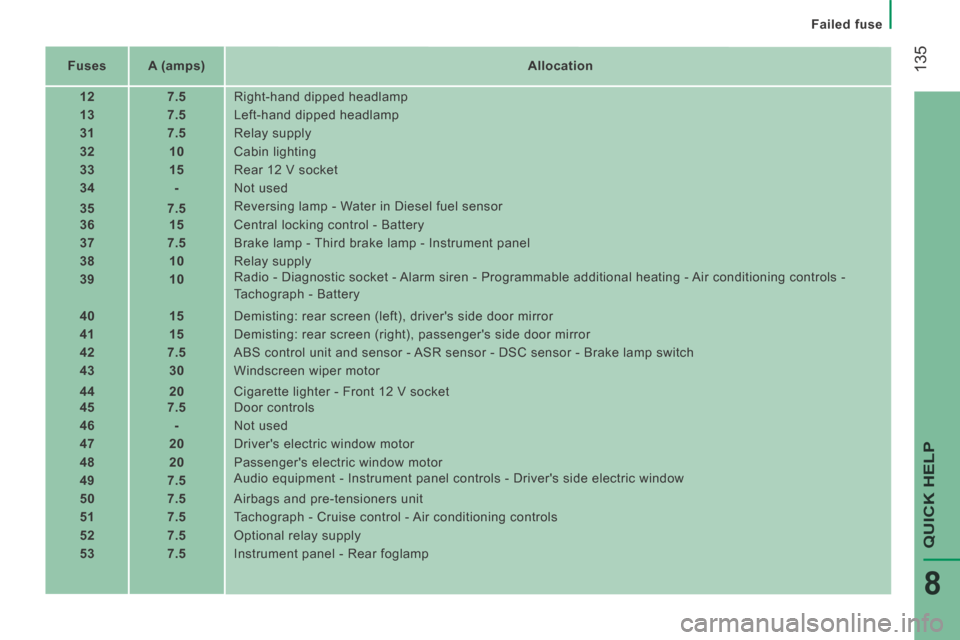
Failed fuse
135
QUICK HELP
8
JUMPER-PAPIER_EN_CHAP08_AIDE RAPIDE_ED01-2014
Fuses A (amps) Allocation
12 7.5 Right-hand dipped headlamp
13 7.5 Left-hand dipped headlamp
31 7.5 Relay supply
32 10 Cabin lighting
33 15 Rear 12 V socket
34 - Not used
35 7.5 Reversing lamp - Water in Diesel fuel sensor
36 15 Central locking control - Battery
37 7.5 Brake lamp - Third brake lamp - Instrument panel
38 10 Relay supply
39 10 Radio - Diagnostic socket - Alarm siren - Programmable additional heating - Air conditioning controls -
Tachograph - Battery
40 15 Demisting: rear screen (left), driver's side door mirror
41 15 Demisting: rear screen (right), passenger's side door mirror
42 7.5 ABS control unit and sensor - ASR sensor - DSC sensor - Brake lamp switch
43 30 Windscreen wiper motor
44 20 Cigarette lighter - Front 12 V socket
45 7.5 Door controls
46 - Not used
47 20 Driver's electric window motor
48 20 Passenger's electric window motor
49 7.5 Audio equipment - Instrument panel controls - Driver's side electric win\
dow
50 7.5 Airbags and pre-tensioners unit
51 7.5 Tachograph - Cruise control - Air conditioning controls
52 7.5 Optional relay supply
53 7.5 Instrument panel - Rear foglamp
Page 138 of 240
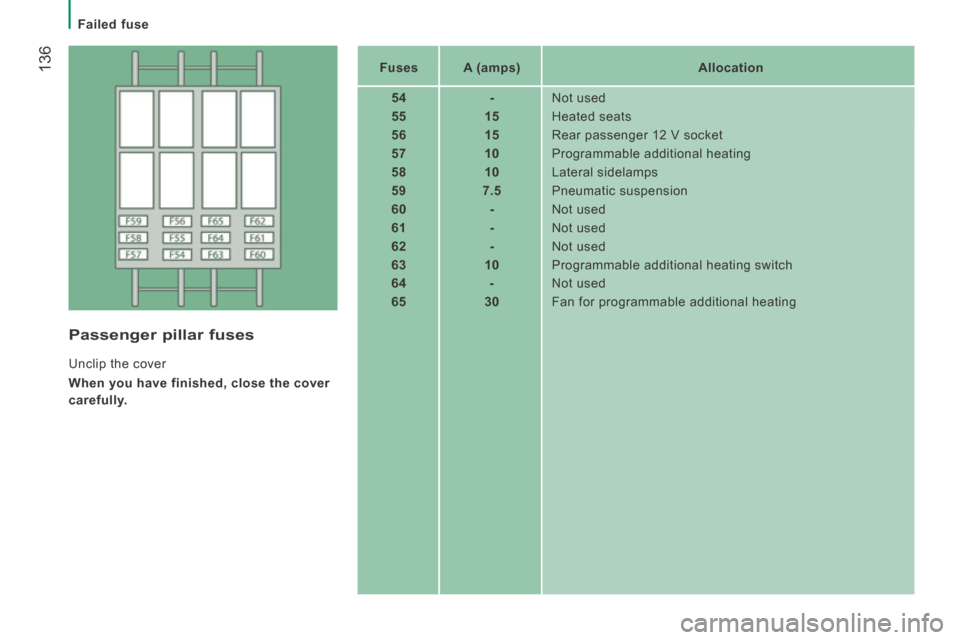
Failed fuse
136
JUMPER-PAPIER_EN_CHAP08_AIDE RAPIDE_ED01-2014
Fuses A (amps) Allocation
54 - Not used
55 15 Heated seats
56 15 Rear passenger 12 V socket
57 10 Programmable additional heating
58 10 Lateral sidelamps
59 7.5 Pneumatic suspension
60 - Not used
61 - Not used
62 - Not used
63 10 Programmable additional heating switch
64 - Not used
65 30 Fan for programmable additional heating
Passenger pillar fuses
Unclip the cover
When you have finished, close the cover
carefully.
Page 139 of 240
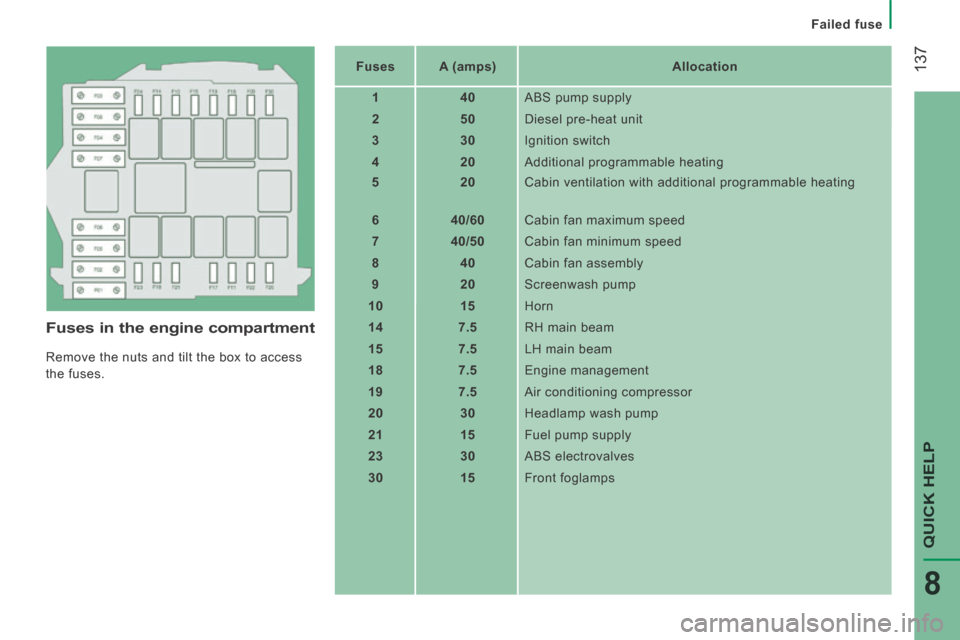
Failed fuse
137
QUICK HELP
8
JUMPER-PAPIER_EN_CHAP08_AIDE RAPIDE_ED01-2014
Fuses in the engine compartment
Remove the nuts and tilt the box to access
the fuses. Fuses
A (amps) Allocation
1 40 ABS pump supply
2 50 Diesel pre-heat unit
3 30 Ignition switch
4 20 Additional programmable heating
5 20 Cabin ventilation with additional programmable heating
6 40/60 Cabin fan maximum speed
7 40/50 Cabin fan minimum speed
8 40 Cabin fan assembly
9 20 Screenwash pump
10 15 Horn
14 7.5 RH main beam
15 7.5 LH main beam
18 7.5 Engine management
19 7.5 Air conditioning compressor
20 30 Headlamp wash pump
21 15 Fuel pump supply
23 30 ABS electrovalves
30 15 Front foglamps
Page 140 of 240
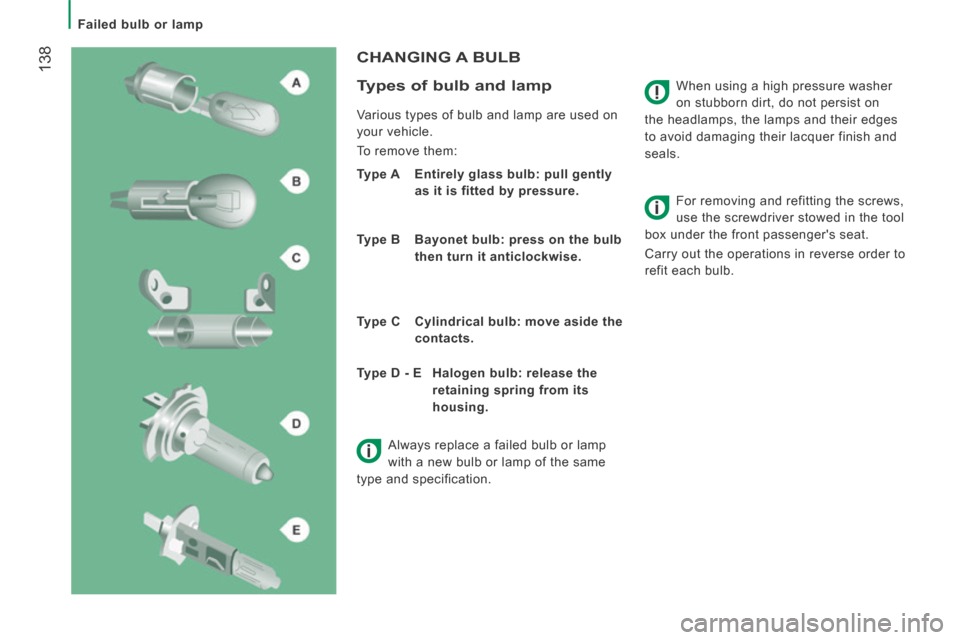
Failed bulb or lamp
138
JUMPER-PAPIER_EN_CHAP08_AIDE RAPIDE_ED01-2014
When using a high pressure washer
on stubborn dirt, do not persist on
the headlamps, the lamps and their edges
to avoid damaging their lacquer finish and
seals.
CHANGING A BULB
Types of bulb and lamp
Various types of bulb and lamp are used on
your vehicle.
To remove them:
Type A Entirely glass bulb: pull gently as it is fitted by pressure.
Type B Bayonet bulb: press on the bulb then turn it anticlockwise.
Type C Cylindrical bulb: move aside the contacts. For removing and refitting the screws,
use the screwdriver stowed in the tool
box under the front passenger's seat.
Carry out the operations in reverse order to
refit each bulb.
Type D - E Halogen bulb: release the retaining spring from its
housing.
Always replace a failed bulb or lamp
with a new bulb or lamp of the same
type and specification.